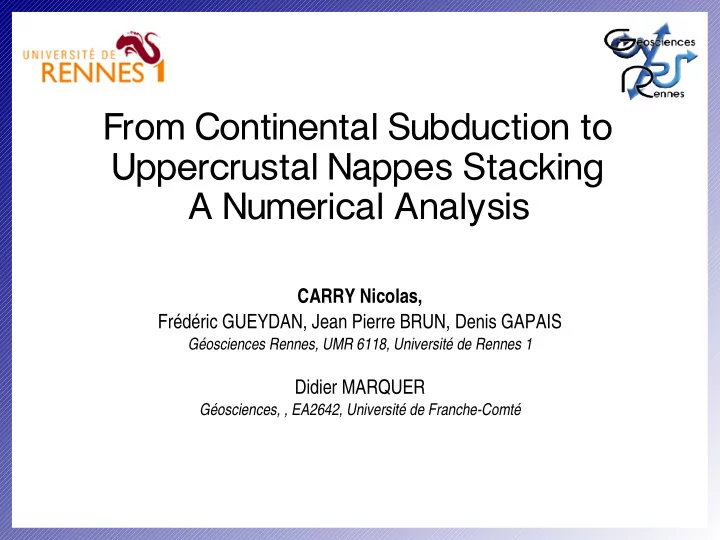

From Continental Subduction to Uppercrustal Nappes Stacking A Numerical Analysis CARRY Nicolas, Frédéric GUEYDAN, Jean Pierre BRUN, Denis GAPAIS Géosciences Rennes, UMR 6118, Université de Rennes 1 Didier MARQUER Géosciences, , EA2642, Université de Franche-Comté
Introduction Continental subduction : between oceanic closure and mountain belt surrection Continental margin : first continental part subducted in moho Lithosphere This study : understand the mechanisms responsible for a detachment of a crustal piece Methods : simple thermal model and force balance analysis
Acting stress Material strength Stacking Natural examples Force balance analysis Strength?? Overlying Ts: Tectonic stress Sum: Acting stress Bs: Buoyancy stress µ O: Overlying weigth stress Acting stress: decrease in overlying lithosphere increase in overlying asthenosphere STACKING OCCURS IF BURIAL MATERIAL STRENGTH < ACTING STRESS
Acting stress Material strength Stacking Natural examples 2D thermal and strength evolution in a subducted continental margin Numerical code SARPP after Y. Leroy & F. Gueydan 2003 100 km 2D finite elements Conductive Transitory No crustal heterogenity 300 km
Acting stress Material strength Stacking Natural examples Thermal and strength evolution 2 My (36,4 km) Temperature Brittle law Strength Ductile law Temperature 4 My (77,34 km) Strength Temperature 6 My (100,9 km) Strength Strength (MPa)
Acting stress Material strength Stacking Natural examples Crustal strength evolution BRITTLE 2 My
Acting stress Material strength Stacking Natural examples Crustal strength evolution BRITTLE 3 My
Acting stress Material strength Stacking Natural examples Crustal strength evolution DUCTILE BRITTLE 4 My
Acting stress Material strength Stacking Natural examples Crustal strength evolution DUCTILE 6 My
Acting stress Material strength Stacking Natural examples Material strength vs Acting stress 2 My BRITTLE DUCTILE 4 My 6 My Stacking Acting stress Material strength Difference between Acting stress and BURIAL Material strength
Acting stress Material strength Stacking Natural examples Stacking evolution 2 My (36,4km) 4 My (77,34 km) Burial depth 45 km 6 My (100,9 km) Difference: Stress - Strength Large difference Detached unit = Able stacking area Weak material Easy stack
Acting stress Material strength Stacking Natural examples Parametric study: crustal units thickness Length Thickness Dip angle and velocity 30° - 10 cm.y-1 20° - 5 cm.y-1 10° - 2,5 cm.y-1 BURIAL 5° - 2,5 cm.y-1 Depth (km) Pressure 0 kb 15kb 45kb 30kb
Acting stress Material strength Stacking Natural examples Parametric study: crustal units length Length Dip angle and velocity 30° - 10 cm.y-1 20° - 5 cm.y-1 10° - 2,5 cm.y-1 BURIAL 5° - 2,5 cm.y-1 Depth (km) Pressure 0 kb 15kb 45kb 30kb
Acting stress Material strength Stacking Natural examples Validation : The Lepontine case Tectonics maps of Central Alps N Gothard Lepontine crustal units Thin and long units Ta Only upper-crustal rocks Su Si Ad Legende Lv Lv: Leventina Ta: Tambo Si: Simano Su: Suretta Ad: Adula 25 km Su Aar Ta Ad Cross section of the Central Alps Si (modified after Schmidt 2004) Lv
Acting stress Material strength Stacking Natural examples Validation : The Lepontine case Tectonics maps of Central Alps N Example : Simano crustal unit ● Pic pressure (D1): 12kbar (R. Rütti, 2003) ● Length: around 35 km Simano ● Thickness: around 2,5 km 25 km Cross section of the Central Alps Simano (modified after Schmidt 2004)
Acting stress Material strength Stacking Natural examples Validation : The Lepontine case Dip angle and velocity 30° - 10 cm.y-1 20° - 5 cm.y-1 10° - 2,5 cm.y-1 5° - 2,5 cm.y-1 Ad Lv Si Ta Su Lv: Leventina Si: Simano Slab angle : Ad Ad: Adula Lv ● Around 20° Ta: Tambo Si ● In agreement with PT angle Su: Suretta Ta Su estimations (for example, Dale & al., 2003) Burial depth (km)
Conclusions The stacking of upper-crustal units in the subduction zone : (1) is a direct consequence of heating from above (2) does not require crust heterogeneity (3) involves thin & long units The modelling results are consistent with the Lepontine nappes example Perspective: estimating the velocity and dip of subduction slabs from P-T datas
Recommend
More recommend